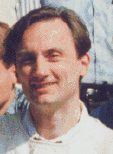
| Internet Consultancy | | | BioInformatics | | | Computational Genetics |
|---|---|---|---|---|

 |
|
 |
I was contracted by the European Molecular Biology Computing Network (EMBnet) Education and Training Programme Committee (E&T PC) to write tutorials for several bioinformatics tools. These tutorials are interactive - you learn from them by following the worked examples and exercises in your own concurrent session with the tool - and are presented via the World Wide Web. Though geared for use by researchers with accounts at one of the EMBnet computing centres, anyone with access to the WWWeb and the computing tool in question is welcome and able to use the tutorials. The only price we ask you to pay is to let me know if and how you think these tutorials could be improved. Helpful comments are honoured!


![]()
Some science to come, though, about just How Different different phylogenetic trees can be. And why you might like to know that.
While you linger for this dogma-shattering relevation, have a look at the Tree of Life, by the Maddison twins. A VERY ambitious project!
I'll also be throwing as many analytical tools as I can find at a "simple gene/enzyme system" - I want to understand how (If! Mustn't beg questions, now ...) its function has constrained its evolution. Or vice versa.
And finally, there are now MANY mitochondrial genomes completely sequenced; I'm keen to know the degree of congruence among phylogenetic trees estimated from the DNA sequences of different gene groups, and I think there are several groups within this DNA segment. Are there enough data for my question? Is there a better way to ask/answer it? And how does the mitochondrial answer compare with answers from other groups in nuclear DNA, e.g., multi-copy genes, such as rDNA, and some single-copy genes, such as many many others have already done? Well, don't hold your breath while you're waiting.
| David
Featherston ( dwf@biobase.dk ) |
Updated: Friday, 30 May, 1997 |
Copyright © 1995-1997 David W. Featherston |
|---|